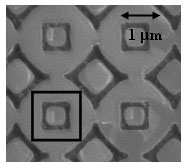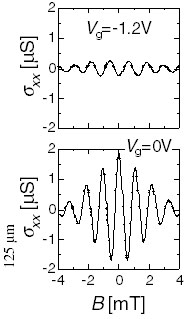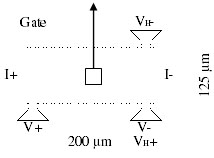Physical Science Laboratory1, PRESTO JST2, CREST JST3
Experimental demonstration of an electric-field-controllable
spin interferometer is reported. In this study, we focused on the spin degree
of freedom rather than the charge degree of freedom used in conventional semiconductor
devices. The electron spin is usually controlled by a magnetic field; however,
it has been demonstrated that the electron spin precession can be controlled
by an electric field. These results are the first step towards new functional
devices that utilize the spin degrees of freedom of electron.
A key to controlling electron spin in a semiconductor is the Rashba spin-orbit
interaction, which makes it possible to control the spin precession by an
electric field. Figure 1(a) shows a scanning electron microscope (SEM) image
of the semiconductor spin interferometers. An array of square loops was fabricated
by the electron beam lithography and a dry etching technique. The lighter
region contains the electron path, and a typical path is outlined by the black
square. Figure 1(b) shows a schematic view of the sample. The entire sample
is covered with a voltage-gate electrode, which makes it possible to control
the spin precession due to the Rashba spin-orbit interaction. The Al’tshuler-Aronov-Spivak
(AAS) oscillations were observed to investigate the angle of the spin precession.
Two partial electron waves that travel along the four sides of the square
in the clockwise and the counter-clockwise directions interfere each other.
Due to the Rashba spin-orbit interaction, the spin precession occurs as these
waves pass through the square loop. The interference depends on the difference
of the angle of the spin precession. The gate voltage, Vg, dependence
of the AAS oscillation amplitude is shown in Fig. 2. With increasing Vg,
the sign of the conductivity, σxx, without a magnetic field, B, changes from
minus to plus. These results show that the electron spin interference is realized
by the electric-field-controllable spin precession.
[1] T. Koga, J. Nitta, M. van Veenhuizen, Phy. Rev. B 70,
161302(R) (2004).
Present Address: Graduate School of Information Science and Technology, Hokkaido
University*, Graduate School of Engineering, Tohoku University‡.
| Fig. 1 | Fig. 2 | ||
| (a) |  |
 |
Fig. 1. (a) A SEM picture of the
spin interferometers. The black square represents a typical electron path.
(b) A schematic view of the sample. The entire sample is covered with
a voltage-gate electrode. Fig. 2. The gate voltage dependence of the AAS oscillations. The sign of σxx at B=0 changes from minus to plus. The electric-field-controllable spin precession results in the modulation of the spin interference. |
| (b) |  |